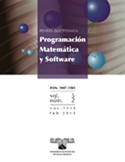Predicting Future Trends On Pet Abandonment
DOI:
https://doi.org/10.30973/progmat/2015.7.1/2Keywords:
Abandonment of animals, Bacterial Foraging Optimization and Public Polices associated with animalsAbstract
In biggest metropolis different kind of pets are living together with their masters, but with a limited time to receive food, attention or even a home where it is possible to find shelter for the rest of its lives. Juarez City has a population over 1.2 million of habitants, many families has different pets including dogs, cats, hamsters, birds, fishes or reptiles that some finished being abandoned in a quickly time, forget in the streets or die due starvation, negligence and selfish of their masters. To understand this social behavior we propose a Multivariable optimization associated with the numerical prediction of its abandoned to establish ecological public polices and determine the social consequences to determine the ecological cost benefit related with the replacement of new issues and increase of pets without master in the streets whereby exists many restrictions, although this problem has been studied on several occasions by the literature failed to realize an adequate numerical prediction evaluating various values associated with each kind of pet and compare its individual costs in each species. There are several factors that can influence to abandon or kill a pet, for our research we propose using a novel bio-inspired algorithm named Bacterial Foraging Optimization (BFO) Algorithm which has been proven to be efficient for predicting social behaviors associated with several aspects, in our case is represented as the increase of young population or adequate ecological public polices with the uncertainty of not knowing when will be too late to change our indifference to our pets.
References
X.S. Yang., Bat algorithm for multi-objective optimisation, International Journal of BioInspired Computation. 2011, 3(5), 267–274, https://doi.org/10.1504/IJBIC.2011.042259
Griffin, D. R., Webster, F. A., Michael, C. R. The echolocation of flying insects by bats, Animal Behaviour. 1960, 8(34), 141 – 154. https://doi.org/10.1016/0003-3472(60)90022-1
Metzner, W. Echolocation behaviour in bats. Science Progress Edinburgh. 1991, 75(298), 453–465.
Schnitzler, H.U., Kalko, E. K. V. Echolocation by insect-eating bats, BioScience. 2001, 51(7), 557–569. https://doi.org/10.1641/0006-3568(2001)051[0557:EBIEB]2.0.CO;2
Cruz, L., Ochoa, A., et al. A Cultural Algorithm for the Urban Public Transportation. HAIS. 2010, 135-142. https://doi.org/10.1007/978-3-642-13803-4_17
Glass, S., Muthukkumarasamy, V., Portmann, M. The Insecurity of Time-of-Arrival DistanceRanging. IEEE 802.11 Wireless Networks. ICDS Workshops. 2010, 227-233. https://doi.org/10.1109/ICDCSW.2010.59
Souffriau, W., Maervoet, J., Vansteenwegen, P., Vanden Berghe, G., Van Oudheusden, D. A Mobile Tourist Decision Support System for Small Footprint Devices, IWANN. 2009, (1), 1248-1255. https://doi.org/10.1007/978-3-642-02478-8_156
Ochoa, A., García, Y., Yañez, J. Logistics Optimization Service Improved with Artificial Intelligence. Soft Computing for Intelligent Control and Mobile Robotics. 2011, 57-65. https://doi.org/10.1007/978-3-642-15534-5_4
Raini, A., Inderveer, C. Bacterial foraging based hyper-heuristic for resource scheduling in grid computing. Future Generation Comp. Syst. (FGCS). 2013, 29(3), 751-762. https://doi.org/10.1016/j.future.2012.09.005
Lijing, T., Hong, W., Xiaoheng, L., Kangnan, X. An Adaptive Comprehensive Learning Bacterial Foraging Optimization. https://doi.org/10.1007/978-3-642-39678-6_33
Downloads
Published
How to Cite
Issue
Section
License
Copyright (c) 2015 Programación Matemática y Software

This work is licensed under a Creative Commons Attribution 4.0 International License.
Usted es libre de:
 |
Compartir — compartir y redistribuir el material publicado en cualquier medio o formato. |
 |
Adaptar — combinar, transformar y construir sobre el material para cualquier propósito, incluso comercialmente. |
Bajo las siguientes condiciones:
 |
Atribución — Debe otorgar el crédito correspondiente, proporcionar un enlace a la licencia e indicar si se realizaron cambios. Puede hacerlo de cualquier manera razonable, pero de ninguna manera que sugiera que el licenciador lo respalda a usted o a su uso. |
| Sin restricciones adicionales: no puede aplicar términos legales o medidas tecnológicas que restrinjan legalmente a otros a hacer cualquier cosa que permita la licencia. |










